Lone Star Drills Answers Frequently Asked Soil Sampling Questions
 Soil sampling is a crucial first step in everything from construction to farming. It provides information about the chemical and physical condition of the soil. Often, the purpose is to test for contamination, nutrients or soil strength to gauge the success of a project. The resulting information helps optimize plant growth, solve soil-related problems or determine the extent of soil contamination.
Soil sampling is a crucial first step in everything from construction to farming. It provides information about the chemical and physical condition of the soil. Often, the purpose is to test for contamination, nutrients or soil strength to gauge the success of a project. The resulting information helps optimize plant growth, solve soil-related problems or determine the extent of soil contamination.
If you’re interested in expanding into soil sampling, our experts answer the most frequently asked questions about the process below.
What does the soil sampling process involve?
Soil sampling processes depend on the overall application. Agricultural soil sampling, like testing for farming, usually requires 10 to 15 soil samples taken from a field at a depth of around 4 inches. For this application, Little Beaver offers a hand sampling tool with samplers between 1.5- and 2-inch diameters.
However, geotechnical soil sampling requires deeper depths. That’s where Lone Star Drills soil sampling drills come in. The smallest drill, the LST1A+, can drill to a depth of 50 feet with a borehole diameter of 6 inches, whereas the largest soil sampling drill, the LSGT+HDA, can drill to a depth of 100 feet.
Why should a soil sample be collected?
Collecting samples identifies soil texture, soil pH levels and the nutrients in the soil. This helps in building and planting applications by showing what type of trees, shrubs and turf will grow in the area and gives an idea of how solid the foundation for a building will be. A soil test can also provide information on the proper amount of lime and fertilizer to apply to lawns, gardens and other landscaping areas.
Geotechnical soil sampling is done to determine the subsurface conditions of the soil. It shows the chemical and physical properties of the earth, evaluates slopes and soil deposit stability, assesses the risks posed by site conditions, helps give information on designing foundations and can even be used to monitor site conditions and foundation construction.
When should soil sampling be done?
Soil sampling timelines depend upon the application. For farming applications, late summer or early fall is a good time for most crops. However, soil sampling can be done at any time throughout the year when it comes to geotechnical applications.
In construction projects, soil sampling happens before and during the building process. It’s often repeated after the foundation is dug and before the footings are placed. It will give information on soil contamination as well as the soil’s suitability for foundations, septic tanks and other below-ground work.
What is the best type of equipment for soil sampling?
 Hand sampling tools are good for environmental soil sampling in things like agricultural practices or other shallow-depth applications. For deeper depths down to 100 feet, a geotechnical drilling rig is the best option. Lone Star Drills offers a full line of drilling rigs and soil sampling accessories to best match the equipment with your project.
Hand sampling tools are good for environmental soil sampling in things like agricultural practices or other shallow-depth applications. For deeper depths down to 100 feet, a geotechnical drilling rig is the best option. Lone Star Drills offers a full line of drilling rigs and soil sampling accessories to best match the equipment with your project.
The SSK-1 Cathead Kit with a manual hammer is standard on the LST1G+ and the LST1G+HD and can also pair with the Big Beaver. The kit includes a third hydraulic valve, tower kit and cathead. With the split spoon sampler, the kit allows users to obtain core samples for environmental testing or geotechnical engineering projects. The manual safety hammer can be added to the kit to drive the split spoon sampler deeper into the soil.
The LST1G+HDA and LSGT+HDA both include an automatic hammer. The automatic hammer transfers consistent energy to the drill rod for standard penetration testing. This form of testing measures the relative density of the soil by tracking the number of hammer drops it takes to drive the sampler into the soil.
A hollow stem auger is available for the Big Beaver, LST1G+, LST1G+HD and LSGT+HDA. In unstable soil conditions, hollow stem augers collect soil samples without the risk of contamination. These augers come in 6- and 8-inch internal diameters. The center rod and center plug can be removed to create a clear path for inserting a soil sampler.
Where can I find more information on soil sampling?
Additional resources for soil sampling are available on the Lone Star Drills website or our YouTube channel. Visit the soil sampling playlist to learn more. Contact us today to speak with an expert about soil sampling equipment or the entire process.